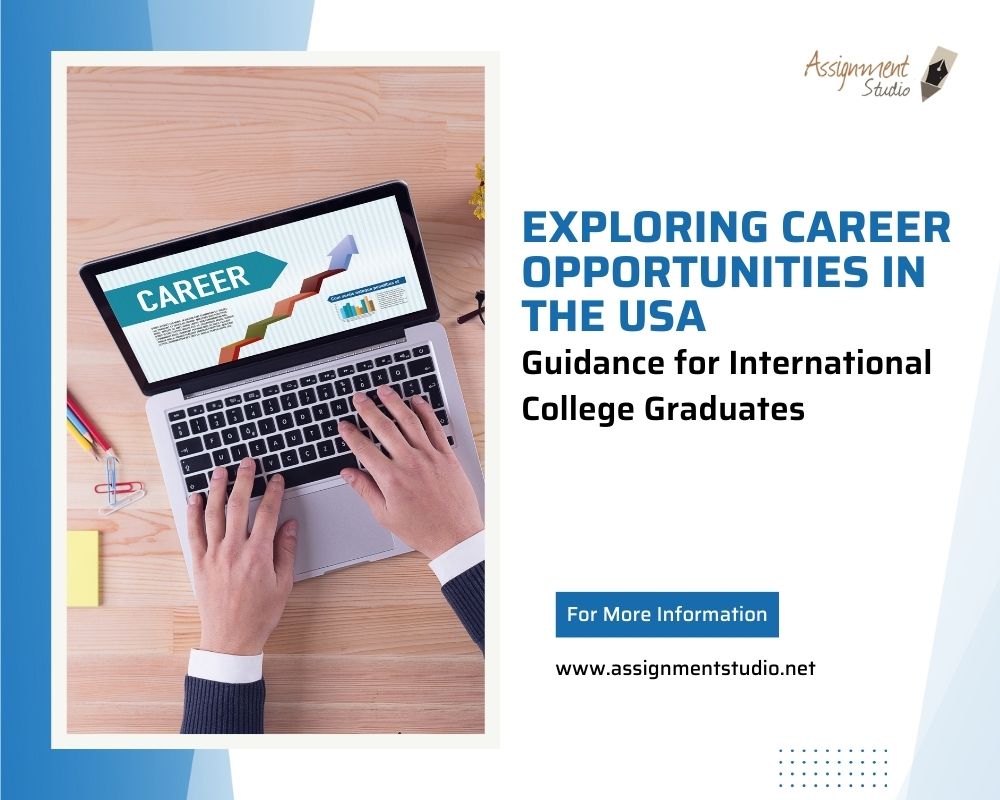
The United States has earned its reputation as the “Land of Opportunities,” making it an attractive destination for international students seeking higher education. It’s only natural that many of these students wish to stay in the country and build their careers after completing their programs. However, the path to living and working in the USA as an international graduate is far from straightforward. There exist numerous intricacies and regulations that must be comprehended and navigated. In this comprehensive blog, we will delve into the essential aspects of establishing a career in the United States following graduation.
Table of Contents
Jobs in the USA
The United States, with its vast territory and a population of 331.9 million, stands as the largest and most influential economy globally. As of the latest available data, the country boasts a relatively low unemployment rate of 3.8%, reflecting its dynamic labour market. Furthermore, the United States is characterised by its diverse and ever-evolving industries, which contribute significantly to its economic prowess. There is expected growth in the industries such as healthcare, social assistance, construction, electronic, IT, hospitality, financial services, real estate, and retail. The United States is also home to one of the world’s largest and most advanced media sectors. Its diverse media landscape encompasses television, film, publishing, digital content, and news outlets, influencing global culture and communication.
Shortage Occupations
Similar to any job market, the United States has particular jobs that are in high demand. If you are looking to quickly find a job with an American company, it is advisable to consider these specific roles. Many of these jobs are specialised professions that demand extensive education and experience, but the list also includes positions with lower requirements that you can pursue after completing short-term training. Below is the list of job roles facing a shortage in the USA in 2023.
- Solar equipment installer
- Wind turbine specialist
- Personal care assistant
- Nurse practitioner
- Statistician
- Assistant physiotherapist
- Software developer
- Mathematician
- Information security analyst
- Operations research analyst
- Health care lecturer
- Physiotherapist
- Nursing instructor
- Accountant and auditor
Follow Visa Rules
In this section of the blog, we will delve into the F-1 visa option. F-1 visas are specifically intended for full-time study, but they do grant students the opportunity to participate in both on-campus and, to a certain extent, off-campus employment related to their field of study. It is important to note that for most of these employment opportunities, prior authorization is required before you can begin working.
F-1: CPT and OPT
Let’s break down some essential visa options for international graduates in simpler terms, keeping it formal and engaging:
Curricular Practical Training (CPT):
Imagine CPT as your passport to gain practical experience while studying in the U.S. It can be a paid or unpaid opportunity that relates to your program of study. To qualify, this job should either be a requirement for your degree or part of a formal agreement between your school and an external employer. It is like getting real-world experience that complements your classroom learning.
Optional Practical Training (OPT):
OPT is like your post-graduation adventure ticket. It allows you to work in the U.S. for up to 12 months in a job directly tied to your major field of study. You can use OPT before or after completing your degree. If you have earned a degree in a STEM field (Science, Technology, Engineering, or Mathematics), you may be eligible for an extra 26 months of OPT. Think of it as a chance to live and work in the U.S. while gaining valuable experience.
H-1B Visa (Specialty Occupation Visa):
H-1B is your golden ticket to staying in the U.S. for an extended period, up to six years. This is for highly specialised graduates. To get it, you will need a U.S. employer to sponsor you. It is like an exclusive invitation to continue your career in the States.
These visa options open doors for international graduates to study, work, and grow their careers in the United States. Whether you are gaining practical experience during your studies or pursuing specialised work after graduation, there’s a path that suits your ambitions.
How to Find A Company to Sponsor You?
Navigating the job market as an international graduate can indeed be challenging. Many companies often prioritise local talent for their job openings, as sponsoring international candidates can be complex and costly. However, there is no need to lose hope, because several U.S. companies are known for their graduate training and sponsorship programs. Here are a few examples:
- Cognizant Technology Solutions
- Amazon
- Microsoft
- Ernst & Young
- Apple
- IBM
- Accenture
Use Your University Careers Service
In every college and university, there is a special place that can be your guiding star for your future career. It is called the Career Service Center, and we highly recommend you take advantage of what they offer. You can connect with this resource by setting up a meeting with a career coach or a designated school official (DSO). They are like your career superheroes. They have a ton of experience in helping students like you find jobs and can even assist you in applying for visas after you finish your studies.
It is like having a friendly, expert ally on your side, someone who can give you great advice on where to begin your career journey. So, don’t hesitate to reach out and make use of this fantastic resource. Your future self will thank you for it!
Networking for Grads: Making Connections in the Industry
Creating a strong professional network is super important for your career when you are an international graduate in the USA. Networking offers tons of great perks, like making connections with people in the industry you want to work in, finding out about job openings, and even getting referrals for jobs.
You can grow your network by doing things like going to events related to your field, becoming a part of professional groups, and using websites like LinkedIn. The key to successful networking is being open-minded and genuinely interested in learning from others while also building relationships that benefit both sides. It is a good idea to take the initiative and reach out to professionals for things like informational chats or opportunities to learn from them. This way, you’re on the path to making your career dreams come true.
Resume and Cover Letter
Your resume is like the VIP ticket to a job opportunity. It is a carefully crafted document that shows off your best and most relevant experiences for a job. In the U.S., a typical resume is usually just one page, although there can be exceptions to that rule. When making your resume, remember not to include personal info like your picture, date of birth, gender, or marital status.
And here is the thing – there are no strict rules for writing a resume because you and your job search are unique. It’s a good idea to have a career advisor look at your resume before you send it out.
Now, let’s discuss the cover letter. Think of it as your chance to say, “Hey, I’m really interested in this job, and I know a lot about your company.” It’s also your way of explaining why you’re a perfect match for the job. So, your resume gets your foot in the door, and your cover letter helps seal the deal.
Undergraduate and a Graduate Dissertation
The distinctions between an undergraduate and a graduate dissertation are marked by the depth, scope, and academic rigor demanded at each level of education. An undergraduate dissertation typically serves as a capstone project, allowing students to demonstrate their understanding of a specific subject within their field of study. These projects often focus on synthesizing existing knowledge, presenting a coherent argument, and showcasing research skills. In contrast, a graduate dissertation, which is a requirement for advanced degrees such as a master’s or a Ph.D., delves deeper into original research. Graduate dissertations necessitate the creation of new knowledge, methodologies, or insights, showcasing the student’s ability to contribute to the academic discourse within their discipline. The graduate-level dissertation demands a higher level of critical analysis, research design, and scholarly contribution, reflecting the student’s mastery and expertise in their chosen field.
Conclusion
In conclusion, pursuing a career in the United States as an international graduate is a journey filled with opportunities. While challenges may arise, your determination and guidance will lead to personal growth and rewarding experiences. Your unique journey, skills, and experiences shape your path. Embrace challenges as opportunities for growth in the “Land of Opportunities.” Seek support, stay open to learning, and let determination guide you toward your American dream. Success is within reach with the right steps.







